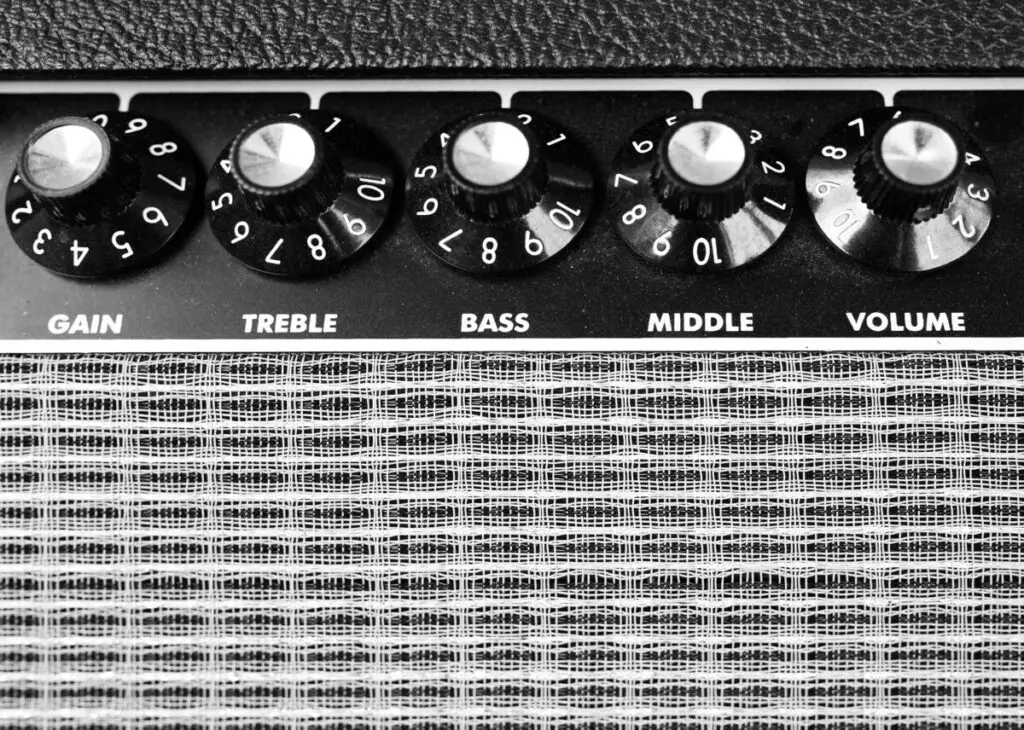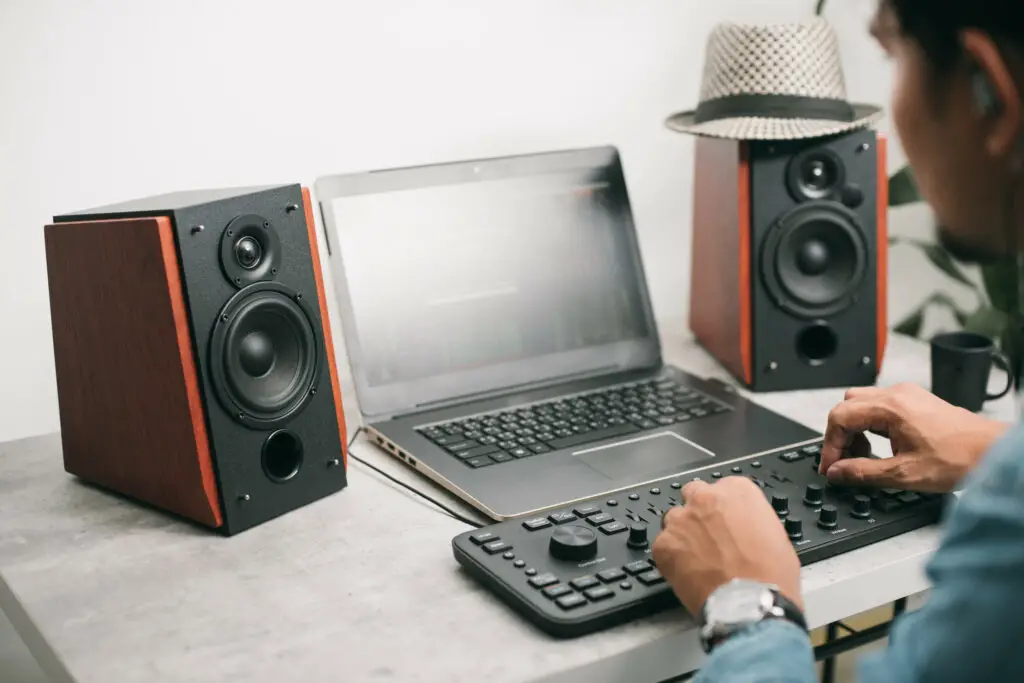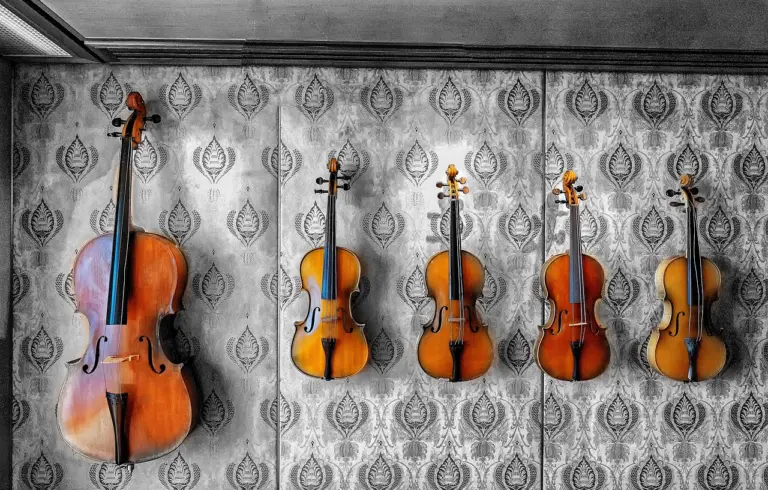What is Midrange in Music? The Power of Frequencies

When you are working on music, you might see the words treble, bass, and mid (or midrange) used to refer to the application of a guitar amp, speaker, or editing software. While some people know these, especially with bass and treble, what does midrange mean?
Midrange describes sounds and music occurring between 250 Hz and 4,000 kHz. This range includes both low-midrange and high-midrange frequencies. The midrange frequency is where the vast majority of sound for music, and it makes it so vocals are clear and crisp.
Now you know what midrange means in music, but if you continue reading, I will go over the details you need to know to be an expert in audio frequencies.
What is an Audio Frequency?
Before I can go into detail about midrange, you must understand the audio frequency. Audio frequency is a measure of a pitch found by determining the distance or period between any two peaks on a wavelength and is measured using hertz (Hz) or kilohertz (kHz). A sound with a lower frequency will sound “lower,” while a higher frequency will sound “higher.”
The audio frequency spectrum comprises all the frequencies the human ear can hear, typically from 20 Hz to 20,000 Hz. While the audio frequency scale is typically broken up into three sections (treble, mid, and bass), there is a more detailed way to break them up below:
- Sub-bass is between 20 Hz and 60 Hz.
- Bass is between 60 Hz and 250 Hz.
- The low midrange is between 250 Hz and 500 Hz.
- Mid-range (excluding low and high midrange values) is between 500 Hz and 4000 Hz.
- The high midrange is between 2000 and 4000 Hz.
- Presence is between 4000 and 6000 Hz.
- Brilliance is between 6000 Hz and 20,000 Hz.
Sub-bass and bass are sometimes called “lows,” while lower midrange, midrange, and higher midrange frequencies are called “mids.” Presence and brilliance are referred to as “highs.” All of these are important to the production of music that is crisp, clear, and pleasant to listen to.
A Deeper Dive On The Three Different Kinds of Midrange

Midrange
Midrange frequencies are between 250 Hz and 4000 kHz on a speaker. These midrange frequencies are typically associated with the sound of human voices.
Typically, the midrange is used in music to help balance both treble and bass music while allowing for vocals to come out crisp and clear. When a singer’s midrange output isn’t clear or edited properly, musical vocals will become distorted or inaudible.
Because of this, the midrange is a crucial part of any music piece. It’s sometimes associated with instruments like guitars, drums, or saxophones. The vast majority of sounds heard in music will be in the midrange, although it is important to note that if the midrange is boosted too much, it can cause listening fatigue.
Lower Mid
The lower midrange runs from 250-500 Hz. This range is critical to music production as the fundamental frequency of many popular instruments lies in this range.
The fundamental frequency is the sound produced by a voice or instrument that is perceived as the loudest by the ear, meaning that the pitch of any one tone is identified based on its fundamental frequency.
Some examples of instruments that you would likely hear that fall into the lower midrange are bass guitars, brass instruments, cellos, and even a majority of mid-woodwinds. Using lower midrange has become more popular over recent years, with artists like Skrillex utilizing a lot of lower midrange mixed with high amounts of bass. Often, male vocalists will fall into the lower midrange as well.
Higher Mid
The higher or upper midrange is important because human ears are naturally sensitive. Found in the 2-4 kHz range, upper midrange sounds must be clear and not excessive to prevent listening fatigue. Because the ear canal resonates at around 3.5 kHz, listening to distorted or overly loud sounds at this frequency can be especially painful.
Considering this, consonant sounds typically are heard at this range as well, which means that if one is to understand what is being said or sung, an upper midrange sound needs to be boosted.
What Should Bass, Mid, and Treble Be Set At?
Because every piece of music differs, there isn’t a perfect setting to leave a speaker on. Along with this, each speaker system is other and has unique settings.
I recommend you play some of your favorite music and play with the treble, mid, and bass settings until you find the settings that make the song sound the best. An equalizer can also help, as it automatically changes the treble, mid, and bass to fit the music.
Boosting the midrange will aid in hearing voices and certain instruments like guitar, but it can lead to listening fatigue. Ensure you can listen to all instruments and notes when tuning your speakers. A good way to do this is to ensure you can hear the instruments in the following table.
Midrange in Audio Production and Mixing
Understanding and manipulating midrange frequencies is fundamental to audio production and mixing.
Carving Space in the Mix
Mix engineers use the midrange frequencies to ‘carve space’ for different elements in a mix. For example, boosting certain midrange frequencies can make a vocal track stand out while reducing others can prevent it from clashing with guitars or keyboards.
Managing ‘Muddiness’
Too much energy in the midrange can lead to a ‘muddy’ mix where elements blend and lose their distinctness. Engineers use techniques, such as careful EQing and dynamic range compression, to manage the midrange and maintain clarity in the mix.
The Importance of Midrange in Various Instruments
The midrange is crucial to the sound of many musical instruments. Here is sorting instrument importance by high, low, and midrange notes:
| Instruments | Frequency |
|---|---|
| Brass, Flutes, Cymbals | High Notes |
| Guitar, Piano, Vocals | Midrange Sounds |
| Bass, Drums | Low Notes |
Guitars
The midrange is especially important for guitars, both electric and acoustic. For instance, the ‘twang’ of a country guitar or the ‘growl’ of a rock guitar is largely a result of specific midrange frequencies.
Keyboards and Synthesizers
For keyboards and synthesizers, the midrange can bring out the body and richness of the sound. Whether it’s a grand piano’s lush tones or a synth lead’s cutting edge, the midrange frequencies are key.
Vocals
In both speaking and singing, the human voice falls primarily in the midrange. This is why midrange frequencies are so critical in any form of vocal production, whether music, podcasts, or broadcasting.







